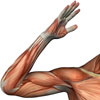Workplace Health

Office ergonomics
Tips for preventing muscle strain
 | Computers are a vital part of the modern office environment and only require a very small range of movement. However, the human body is not designed for sitting at a computer workstation for long periods of time. This means that muscle strain injuries are more likely to occur. |
For more information, see Office Ergonomics – Tips for Preventing Muscle Strain.
Managing mental health
 | Organisations that are able to successfully create and sustain an office environment that promotes good mental health are more likely to minimise the negative financial impact that can result from absenteeism, high staff turnover, workers compensation claims and low morale. |
For more information, see Office Ergonomics – Managing Mental Health.
Preventing eye strain
 | The use of computers amongst office workers has increased markedly over the past two decades. This has resulted in an increase in health disorders associated with computer use, the most common of which are eye and vision problems. |
For more information, see Office Ergonomics – Preventing Eye Strain.
Workplace dangers
Eye injuries in the workplace
 | There are a range of agents found in workplaces that can cause eye diseases, disorders or injuries. While many of these agents are often also found in everyday living environments, exposure at dangerous levels is most likely to occur in the workplace. |
For more information, see Eye Injuries in the Workplace.
How arc discharge affects health
 | Arc discharge is the discharge emitted from electric welding arcs. The exact levels of ultraviolet (UV) radiation produced by a welder depend on the length of exposure time, the type of current the welder uses, the shielding gas the welder uses and the type of metal being welded. |
For more information, see How Arc Discharge Affects Health.
Obesity and its cost on the workforce
 | Obesity is costing the Australian economy $637 million dollars each year due to indirect costs associated with increased sick leave, lower productivity, unemployment, disability, early retirement and workplace injuries. This is in addition to the $1.08 billion obesity related healthcare costs. |
For more information, see Obesity and its Cost on the Workforce.
Sperm and environmental factors
 | People are constantly exposed to a range of chemicals and toxins in their environment which can affect their health, including their reproductive health. For men, a range of environmental exposures are associated with reduced sperm concentration and quality. |
For more information, see Effect of Environmental Factors on Sperm Health.
Work-life balance
 | Work-life balance refers to an individual’s ability to balance the commitments, responsibilities and goals relating to their paid work (e.g. working hours, expected outputs of the job, career advancement), with personal commitments, responsibilities and desires (e.g. parenting, recreational activities, community commitments, further education). |
For more information, see Work Life Balance.
Video: Technology
 | It may be a cliché, but technology has changed our lives. Dr Joe Kosterich talks about the effect of technology on our health and wellbeing, including computers, mobile phones and the internet, and ways to reduce the negative effects on our lifestyles. Watch the video Technology. |
Work-life balance and parenting
 | There are many challenges faced by men and women as they attempt to find and maintain a balance between work and parenting. While most families find it necessary for at least one parent to work in order to provide for the material needs and other desires, combining work and parenting can interfere with a working parent’s ability to dedicate sufficient time to their family. |
For more information, see Work Llife Balance and Parenting.
Breastfeeding and the workplace
 | Combining work and breastfeeding can create considerable pressures for working women with newborn babies as some workplaces are not "breastfeeding friendly". As a result, working mothers are less likely to breastfeed their babies than non-working mothers. |
For more information, see Breastfeeding and the Workplace.
Dates
Created by:

 Login
Login














